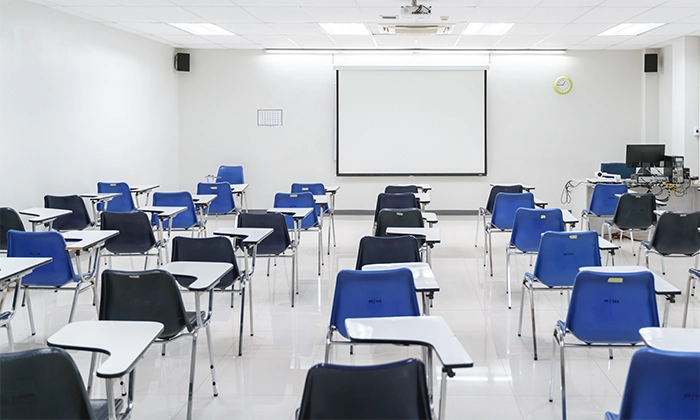Alternative measures to banning phones in the classroom

As of the first term in 2020, a blanket ban on mobile phones will be implemented in Victoria, with the state government primed to spend $12.4 million in enforcing this rule. Given that a recently conducted survey of 2,000 Australian adults by Monash University saw 80% support the idea of phone bans, we may well see several other states follow Victoria’s lead in the years to come.
However, at the risk of swimming against the tide, it is important to ask the question: is this really a good thing? What is notable is the conspicuous lack of research buttressing the decision. Furthermore, whether or not such a ban will make a serious dent in that which it seeks to combat - cyberbullying and inattentive classroom behaviour - is a question without a definitive answer to date.
The jury remains out, and will be until the fruits of this measure can be harvested and analysed. In the meantime, it is worth considering what other measures might be taken to tackle cyberbullying and inattention, and whether or not these efforts might be a more viable solution than a blanket ban on classroom smartphones.
Educating students on cyberbullying
Even the staunchest supporter of a mobile phone ban in schools would have to concede that this will not eliminate the relevance of phones to teenage lives. The unfortunate truth is that cyberbullying amongst classmates is as prevalent outside the class as in; a ban merely removes this damaging practice from the classroom, rather than actively engaging with the issue.
If targeting cyberbullying is the aim of the game, then it stands to reason that confronting the issue head-on offers the best chance of making a dent. The more comprehensive education on offer about how to respond to cyberbullying, the availability of support networks to students, and the repercussions for those who target others, the better chance a school has of minimising the danger.
Dedicating school hours to confronting and discussing cyberbullying takes the issue out of the shadows where it can thrive. It also creates clear avenues for students suffering from cyberbullying to seek protection, or for those witnessing it to be able to recognise it and step up. Whether or not mobile phones are banned in the classroom, tackling the dangerous ways they can be used is assuredly more useful than assuming that out of sight means out of mind.
Embracing technology
Nothing quite splits opinion like technology and children. Plenty of parents and teachers alike are wary or even outright hostile towards the introduction of new technologies into the classroom – indeed, this distrust of technology is surely a significant contributing factor to the mobile phone ban.
The unavoidable truth, however, is that technology is a major part of the lives of younger generations. Having grown up in the era of smartphones and near constant internet access, they do not only possess an in-built expertise when it comes to adapting to new resources, but an expectation of instant availability and accessibility concerning information.
Rather than pushing attempting to curb this impulse in the name of combatting inattentiveness, perhaps the best course of action is to harness it for good. Research by Antero Garcia into the use of mobile phones in a classroom on English ninth-graders in the US found that, with the informed and proactive guidance of their teacher, students could utilise their technological skills to significantly enhance their learning capabilities in the classroom.
Taking the steps to embracing mobile phones being used in the classroom, or “m-Learning”, is for some a bridge too far to cross. But the spirit of the idea – replacing analog methods of education with technology-powered methods such as flipped classrooms and e-learning – will go a long way towards tapping into the existing skills of technology-literate children, in the process transforming their inattentiveness into a new level of active, fruitful participation.
Age appropriate measures
It does not take a genius to recognise that what is expected behaviour-wise for a five year old is quite a far cry from the equivalent expectation of an eighteen year old. However, a blanket ban leaves very little room for such nuance.
Consider the results of review undertaken by the New South Wales government into the pros and cons of mobile phone usage in schools in June 2018, spearheaded by child psychologist Michael Carr-Gregg. The review’s conclusion was that, while a ban on mobile phone usage was a desirable outcome for the state’s primary schools, there was not enough evidence for them to believe such a black and white measure was necessary on secondary level.
The idea of minimising mobile phone usage for those in younger age groups is, who are liable to lack the self-control to avoid using them for anything other than distraction, holds water. But believing teenagers are similarly ill-equipped runs the risk of alienating and infantilising a demographic notorious for wanting to be treated as adults. Implementing rules around mobile phone usage that reflect the relative maturity of those to whom they apply may be a measure more likely to achieve success than a one size fits all ban for students of all ages.
Teacher education
The most important resource within the classroom for nearly all issues remains, of course, the teacher. The success or failure of initiatives to tackle cyberbullying and inattentiveness will ultimately rest mostly on the shoulders of the teachers undertaking them.
With a recent study in Childrens & Schools finding that half of school social workers surveyed feel ill-equipped to handle cases of cyberbullying, the sheer importance of staying up to date with different technologies and how they are used is of paramount importance. Taking advantage of workshops, webinars, and professional consultants that deal with the best practices of taking on cyberbullying should be a priority for schools.
While the need is perhaps less acute when it comes to utilising technology to combat inattentiveness, the same logic applies. Whatever a blanket ban on mobile phones may or may
not achieve, it pales in comparison to the potential value a teacher can bring to the struggles against cyberbullying and classroom inattentiveness. As such, making sure that teachers are armed with the best and most relevant knowledge and skills to take these challenges on is essential.
Complex problems have complex solutions
The twin problems tied up in modern technologies of cyberbullying and classroom inattention are, for better or worse, far from straightforward. As such, a straightforward measure to combat them – such as simply removing all smartphones from schools – is very unlikely to solve them on its own. Multiple efforts will be required to deal with these issues.
While we await the results of Victoria’s mobile phone ban, we could do a lot worse than embrace education for students and teachers alike, explore classroom technologies, and trial age-appropriate mobile phone rules. Used together, such practices may just bring us a lot closer to the goal of safe, secure, and actively engaged students, happy and motivated to come to school, regardless of whether they have their smartphone in their pocket or not.
Liked what you read? Check out more great articles:
Addressing the concerns about flipped learning
References
Subscribe to our newsletter
Get the latest teaching and learning insights delivered to your inbox.
You can unsubscribe at any time, no hard feelings.
Subscribe to our newsletter
Get the latest teaching and learning insights delivered to your inbox.
You can unsubscribe at any time, no hard feelings.
What's Atomi?
Easy to understand, super engaging, and matching what you’re learning in class. Available for 100s of subjects across your high school years.
With heaps of questions and smart AI feedback that shows you what you’ve nailed and what to work on—so you won’t just feel ready, you’ll be ready.
Improve your study game, get AI-driven tips tailored to you, keep tabs on your progress and unlock insights so you can always hit your goals.
What's Atomi?
Captivating and impactful video-first content, fit for all types of learners and grounded in the absolute must-have info of the high school curriculum.
Active recall quizzes, topic tests and exam practice enable students to get immediate feedback and build skills, while allowing teachers to differentiate instruction.
Create engaging learning experiences with easy-to-use tasks, get actionable insights to differentiate instruction and experience intelligent personalisation for your students.
What's Atomi?
Short, curriculum-specific videos and interactive content that’s easy to understand and backed by the latest research.
Active recall quizzes and practice sessions enable students to build their skills, put knowledge into practice and get feedback.
Our AI understands each student's progress and makes intelligent recommendations based on their strengths and weaknesses.




